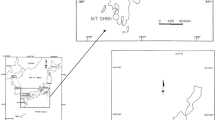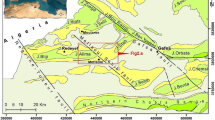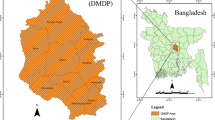Abstract
Landslide and human mortality have been a common phenomenon in the Rangamati district over the past several years. This study examined the geotechnical properties (e.g., grain size analysis, plasticity index, liquid limit index) and geochemical properties (e.g., erodibility index, weathering index, K factor value, redness rating) of the soil in order to determine the causes and vulnerability of the landslide. Three types of soils (sand, silt and clay) have been classified based on grain-size distribution for geotechnical and geochemical analyses. The geotechnical properties of the soils examined indicate that most soils are sandy loams, of poor quality and plastic in nature. Geochemical properties show that the weathering index is higher for the clayey soil which is about 3.65 and the erosion index is higher found in the silty soil of ~ 6.7. The stability index is very low (~ 0.06), and the K factor value is higher 0.046 for the non-cohesive sandy soil which indicates high susceptibility of landslide. Numerical analysis based on geotechnical properties of the soil indicates that the steep slopes are even stable at the dry condition, while it is in risk at wet condition. A bio-engineering approach was proposed which showed that local plants could withstand and render stable in the barred slope in a few years.


Source: BMD (2018)

Source: BMD (2018)











Similar content being viewed by others
References
Abdalla JA, Attom MF, Hawileh R (2015) Prediction of minimum factor of safety against slope failure in clayey soils using artificial neural network. Environ Earth Sci 73:5463–5477. https://doi.org/10.1007/s12665-014-3800-x
Ahasan MN, Chowdhury MAM, Quadir DA (2013) Simulation of high impact rainfall events over southeastern hilly region of Bangladesh using MM5 model. Int J Atmos Sci 13:657108. https://doi.org/10.1155/2013/657108
Ahmed B (2015) Landslide susceptibility mapping using multi-criteria evaluation techniques in Chittagong Metropolitan Area, Bangladesh. Landslides 12:1077–1095. https://doi.org/10.1007/s10346-014-0521-x
Ahsan MS (2013) Rangamati-Chittagong Road Cut Section, Rangamati, Bangladesh. Geological Science, Jahangirnagar University, Savar, Dhaka
Alam E (2020) Landslide hazard knowledge, risk perception and preparedness in southeast Bangladesh. Sustainability 12:6305
Begum A, Islam MS, Hasan MM (2020) Landslide susceptibility mapping using GIS and Remote Sensing: a case study of the Rangamati District Bangladesh RESEARCH. Geogr Inf Syst Preprint. https://doi.org/10.21203/rs.3.rs-23600/v1
Bishop SM (1964) Landslides on logged areas in southeast Alaska. USDA Forest Service, Northern Forest Experiment Station Research Paper NOR-01, pp 1–18
BMD (2018) The monthly and yearly rainfall data of Rangamati district. Bangladesh Meteorological Department, Peoples Republic of Bangladesh, Agargoan
Borselli L, Torri D, Poesen J, Iaquinta P (2012) A robust algorithm for estimating soil erodibility in different climates. CATENA 97:85–94. https://doi.org/10.1016/j.catena.2012.05.012
Brabb EE (1984) Innovative approaches to landslide hazard mapping. In: 4th Int. Symp. Landslides, Toronto, pp 307–332
Carrière SR et al (2018) Rheological properties of clayey soils originating from flow-like landslides. Landslides 15:1615–1630. https://doi.org/10.1007/s10346-018-0972-6
Crozier MJ (1986) Landslides: causes, consequences and environment. Management issues. Croom Helm, London
Dengiz O, Mustafa SH, Oguz B (2013) Weathering rates and some physicochemical characteristics of soils developed on a calcic toposequences Carpath. J Earth Environ Sci 8:13–24
Egbueri J, Igwe O, Nnamani CH (2017) Assessment of the engineering properties and suitability of some tropical soils as backfill materials. Int J Trend Sci Res Dev 2:590–605
El Jazouli A, Barakat A, Khellouk R (2020) Geotechnical studies for Landslide susceptibility in the high basin of the Oum Er Rbia river (Morocco). Geol Ecol Landsc. https://doi.org/10.1080/24749508.2020.1743527
Fan L, Lehmann P, Or D (2016) Effects of soil spatial variability at the hillslope and catchment scales on characteristics of rainfall-induced landslides. Water Resour Res 52:1781–1799. https://doi.org/10.1002/2015wr017758
Gani MR, Alam MM (2003) Sedimentation and basin-fill history of the Neogene clastic succession exposed in the southeastern fold belt of the Bengal Basin, Bangladesh: a high-resolution sequence stratigraphic approach. Sediment Geol 155:227–270. https://doi.org/10.1016/S0037-0738(02)00182-3
Glade T (1998) Establishing the frequency and magnitude of landslide-triggering rainstorm events in New Zealand. Environ Geol 35:160–174. https://doi.org/10.1007/s002540050302
Glade T (2000) Modelling landslide-triggering rainfalls in different regions of New Zealand – the soil water status model. Zeitschrift fur Geomorphologie 122:63–84
Goto A, Tatsumi Y (1994) Quantitative analysis of rock samples by an X-ray fluorescence spectrometer (I). Rigaku J 11:40–59
Goto A, Tatsumi Y (1996) Quantitative analysis of rock samples by an X-ray fluorescence spectrometer (II). Rigaku J 13:20–38
GSB and USGS (2001) Geological Map of Bangladesh; U.S. DEPARTMENT OF THE INTERIOR U.S. GEOLOGICAL SURVEY; Digitally compiled by F.M.Persits, C.J.Wandrey, R.C. Milici, (USGS), and Manwar, A (Geological Survey of Bangladesh, GSB) [Original Geological Map by Alam, M.K, Hasan, AKM S. and Khan, MR (GSB), and Whitney, JW (USGS 1990]
Harnois L (1988) The CIW index: a new chemical index of weathering. Sediment Geol 55:319–322. https://doi.org/10.1016/0037-0738(88)90137-6
Hufschmidt G, Crozier M, Glade T (2005) Evolution of natural risk: research framework and perspectives Nat Hazards Earth. Syst Sci 5:375–387. https://doi.org/10.5194/nhess-5-375-2005
Huq ISM, Hoque AFMM (2012) Land and soil resources database for grass root agricultural development in Bangladesh. Paper presented at the In international conference on advancing the science and technology of soil information in Asia-launch of the Global Soil Partnership’s Asia Soil Science Network and Global Soil Map. net East Asia Node, Nanjing, China
Huq SM, Imamul S, Uddin MJ (2013) The soils of Bangladesh, vol 1. World Soils Book Series, 1st edn. Springer Netherlands, Dordrecht
Igwe CA (2005) Erodibility in relation to water-dispersible clay for some soils of eastern Nigeria. Land Degrad Dev 16:87–96. https://doi.org/10.1002/ldr.647
Igwe O, Egbueri JC (2018) The characteristics and the erodibility potentials of soils from different geologic formations in Anambra State, Southeastern Nigeria. J Geol Soc India 92:471–478. https://doi.org/10.1007/s12594-018-1044-1
Islam MS, Hoque F (2014) River bank erosion of the Surma River due to slope failure. Int J Res Innov Earth Sci 1:54–58
Islam MS, Rahman MA (2019) Slope stability problem and bio-engineering approach on slope protection: case study of Cox’s Bazar Area Bangladesh. Geotech Eng J SEAGS & AGSSEA 50:39–46
Islam MS, Hussain MA, Khan YA, Chowdhury MAI, Haque MB (2014) Slope stability problem in the Chittagong City, Bangladesh. J Geotech Eng 1:13–25
Kafy AA, Hasan MM, Ferdous L, Ali MR, Uddin MS (2017) Application of artificial hierarchy process for landslide susceptibility modelling in Rangamati Municipality Area, Bangladesh. Paper presented at the International Conference on Disaster Risk ManagementAt: BUET-Japan Institute of Disaster Prevention and Urban Safety (BUET-JIDPUS), Dhaka, Bangladesh
Khan YA, Lateh H, Baten MA, Kamil AA (2012) Critical antecedent rainfall conditions for shallow landslides in Chittagong City of Bangladesh. Environ Earth Sci 67:97–106. https://doi.org/10.1007/s12665-011-1483-0
Kyrylchuk A, Haskevych V (2018) Gross chemical composition transformation of Rendzinas in Malyi Polissya under the influence of deflation. Polish J Soil Sci 2018:51. https://doi.org/10.17951/pjss.2018.51.2.283
Mia MT, SultanaPaul NA (2015) Studies on the causes, impacts and mitigation strategies of landslide in Chittagong city, Bangladesh. J Environ Sci Nat Resour 8:1–5
Nebeokike UC, Igwe O, Egbueri JC, Ifediegwu SI (2020) Erodibility characteristics and slope stability analysis of geological units prone to erosion in Udi area, southeast Nigeria. Model Earth Syst Environ 6:1061–1074. https://doi.org/10.1007/s40808-020-00741-w
Nesbitt HW, Young GM (1982) Early Proterozoic climates and plate motions inferred from major element chemistry of lutites. Nature 299:715–717. https://doi.org/10.1038/299715a0
Nesbitt HW, Markovics G, Price RC (1980) Chemical processes affecting alkalis and alkaline earths during continental weathering. Geochim Cosmochim Acta 44:1659–1666. https://doi.org/10.1016/0016-7037(80)90218-5
Parker A (2009) An index of weathering for silicate rocks. Geol Mag 107:501–504. https://doi.org/10.1017/S0016756800058581
Price JR, Velbel MA (2003) Chemical weathering indices applied to weathering profiles developed on heterogeneous felsic metamorphic parent rocks. Chem Geol 202:397–416. https://doi.org/10.1016/j.chemgeo.2002.11.001
Pye K, Johnson R (1988) Stratigraphy, geochemistry, and thermoluminescence ages of lower Mississippi Valley loess. Earth Surf Process Landforms 13:103–124. https://doi.org/10.1002/esp.3290130203
Reichenbach P, Rossi M, Malamud BD, Mihir M, Guzzetti F (2018) A review of statistically-based landslide susceptibility models. Earth Sci Rev 180:60–91. https://doi.org/10.1016/j.earscirev.2018.03.001
Reimann K-U (1993) Geology of Bangladesh. Volume Beiträge zur regionalen Geologie der Erde. Gebruder Borntraeger, Berlin
Reynolds WD, Drury CF, Tan CS, Fox CA, Yang XM (2009) Use of indicators and pore volume-function characteristics to quantify soil physical quality. Geoderma 152:252–263. https://doi.org/10.1016/j.geoderma.2009.06.009
RHDC (2011) Overview of Rangamati. http://rhdcbd.org/old/about_rangamati.php. Accessed 15 May 2020
Richter G, Negendank JFW (1977) Soil erosion processes and their measurement in the german area of the Moselle river. Earth Surf Process 2:261–278. https://doi.org/10.1002/esp.3290020217
Rocscience L (2002) SLIDE software for calculating Hoek-Brown Rock mass strength, vol 6.0, 2011 edn. Rocscience, Toronto
Sahi S, Singh S, Sinha A, Acharya B (1977) Erosion Index-a new of soil erodability Indian Society of. Soil Sci 25:7–10
Sarwar GM (2008) Landslide tragedy of Bangladesh. Paper presented at the first world landslide forum, United Nations University (UNU), Tokyo, Japan
Sowers GF (1979) Introductory soil mechanics and foundations: geotechnical engineering, 4th edn. Macmillan Publishing, New York
SRDI (1997) Annual report. Soil Resource Development Institute, Dhaka
Steckler MS et al (2016) Locked and loading megathrust linked to active subduction beneath the Indo-Burman Ranges. Nat Geosci 9:615–618. https://doi.org/10.1038/ngeo2760
Tamhane R, Dutta N (1965) Water stable aggregates in relation to physical constant of soils. J Indian Soc Soil Sci 13:201–205
van Asch TWJ, Malet J-P (2009) Flow-type failures in fine-grained soils: an important aspect in landslide hazard analysis. Nat Hazards Earth Syst Sci 9:1703–1711
Vogel D (1975) Precambrian weathering in acid metavolcanic rocks for the Superior Province Vallebond Township, Southcentral Quebec. Can J Earth Sci 12:2080–2085
Voicu G, Bardoux M, Voicu D (2018) Mineralogical norm calculations applied to tropical weathering profiles. Mineral Mag 61:185–196. https://doi.org/10.1180/minmag.1997.061.405.03
Walker LR, Shiels AB (2013) Physical causes and consequences for Landslide Ecology. National Wildlife Research Center - Staff Publications, USDA
Watson A, Marden M (2005) Live root-wood tensile strengths of some common New Zealand indigenous and plantation tree species. N Z J For Sci 34:344–348
Acknowledgements
The authors are grateful to University Grants Commission of Bangladesh for financial support (FY 2018-19) to carry out the research work. Authors are also thankful to Dr. M.M. Rahman, CEP, SUST, for his help during tensile strength measurement. We also thank two anonymous reviewers for their constructive feedback and suggestions on the manuscript, which significantly enhance this article.
Author information
Authors and Affiliations
Corresponding author
Additional information
Publisher's Note
Springer Nature remains neutral with regard to jurisdictional claims in published maps and institutional affiliations.
Supplementary Information
Below is the link to the electronic supplementary material.
Rights and permissions
About this article
Cite this article
Islam, M.S., Begum, A. & Hasan, M.M. Slope stability analysis of the Rangamati District using geotechnical and geochemical parameters. Nat Hazards 108, 1659–1686 (2021). https://doi.org/10.1007/s11069-021-04750-5
Received:
Accepted:
Published:
Issue Date:
DOI: https://doi.org/10.1007/s11069-021-04750-5




